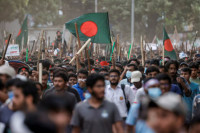Opinion
Drafting challenges
Without the committed intervention of citizens and political parties this draft will pose huge long-term problems
Problematic clauses
Among other things, the draft fails to guarantee: equal citizenship rights for women; freedom from torture; full freedom of expression and press and meaningful inclusion of the historically marginalised and excluded in state structures. In terms of inclusion and the restructuring of the state, there are particularly problematic omissions and clauses. These include the absence of patriarchy in the preamble as part of the history of structural discrimination in Nepal, the clear structuring of federalism as centralised decentralisation—including the power of the center to dissolve the province’s council of ministers and parliament—and the curious positioning of the Khas-Arya social group before Madhesis, Tharus and Muslims in the list of those with rights to social justice.
The above touches upon just a few of the problematic clauses and issues of the draft constitution which render it far from the vision of a constitution that guarantees equality and social justice in a new Nepal. Given this, it is hard to argue—as Jagannath Adhikari did in this paper a few days earlier (‘Better days ahead,’ July 1, Page 6)—that “now is the time to institutionalise and operationalise all positive gains and move forward.” A close study of the draft reveals stipulated rights being neutralised in other sections by clever word-plays in which the Nepali officialdom excels. For the historically marginally and excluded, there are few positive gains.
Regressive progress
This is especially so when one remembers the drafts produced in the first CA by the different thematic committees. These were products of intense debates and compromises by elected CA committee members appointed according to CA regulations on the basis of proportional inclusion with ‘the presence of all minorities, including women, indigenous nationalities/Janajatis, Madhesis, Dalits, people from backward regions and Muslims’. Given the overwhelming absence of political party leaders from these committee meetings (and the CA as a whole) at that time, it is not surprising that the drafts initially produced were so progressive in terms of rights guaranteed and attention to issues of inclusion and social justice.
In the aforementioned article, Adhikari states that, “By following democratic processes, there will be opportunities to refine the government’s structure and content of the constitution in a way that will benefit marginalise communities.” The history of the first CA has taught us that democratic processes are not always followed by the political elite. A parallel process of decision-making has always existed with senior political party members deciding on constitutional issues outside of the CA. Following the production of the progressive drafts, in the name of ‘consensus’ the constitution-writing process was shifted from the first elected CA body to a handful of elected and, importantly, unelected, high-caste, men. The history of the stalemates that ensued and the abrupt termination of the first CA tenure and the declaration of elections for a second CA is all known history.
The second CA was intended to complete the work started in the first CA. Indeed, the ownership of the constitutional agendas agreed upon by the previous CA was reflected in the reduced number of committees and the central role of one of them: the Committee to Study and Determine Constitutional Records. This committee was not bound by the second CA rules and regulations to be inclusive but neither was the committee headed by Krishna Sitaula conceptualised as what critics are now calling it, a ‘constitution-writing commission’: it was not mandated to undo previous agreements, nor to add issues not agreed upon. Adhikari writes, “I prefer any progression over none.” For those interested in securing basic rights and social justice in a fully functioning democracy, this ‘progression’ cannot be termed anything other than ‘regression’.
Democratic processes are key to the writing of a people’s democratic constitution. The Minister for Information and Communications Minendra Rijal has stated that the new constitution will be finalised only after taking feedback from the people and parties. Yet the timeline and modalities for garnering, and including, feedback from citizens into the draft have not been made clear. Importantly, The Kathmandu Post had earlier reported (June 25) that the Nepali Congress was for a shortened time allocation for public discussions while the latter was thought to be unnecessary by the CPN-UML and UCPN (Maoist) given the monsoon and the earthquake. Democratic processes have never—fast track or not—been high on the agenda of Nepal’s political elite.
Flouting laws
This is made most evident by the issue at the crux of this new draft—its legality. In defiance of the country’s Supreme Court the four major parties implemented their 16-point agreement and produced a draft that does not delineate the boundaries of the federal provinces, leaving the actual delineation to a commission to be established later. This is a reflection of the continued willingness of high-caste, male political elites to flout the rule of law and take processes out of the hands of elected officials. Yet clearly, violating the rule of law and bypassing elected officials are not the foundations on which a people’s democratic constitution for a new Nepal should be established.
There was little Nepalis could do about the April earthquake. Nature and natural disasters are hard to control. The draft constitution is, and should be, another story. But without the intervention of citizens and political parties that are committed to making a just and rule of law-based democratic Nepal, this draft—as with the earthquake—will pose huge long-term challenges to the rebuilding of the new nation.
Tamang is a political scientist




 5.39°C Kathmandu
5.39°C Kathmandu









%20(1).jpg&w=300&height=200)

